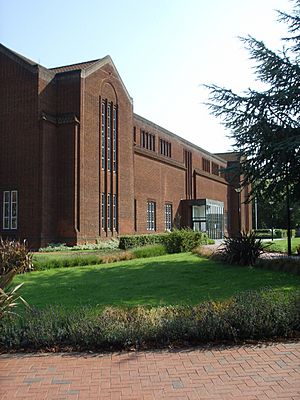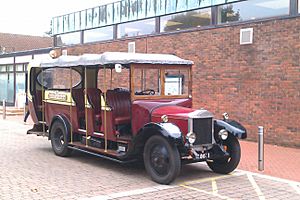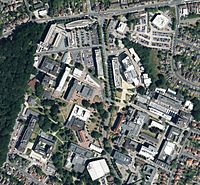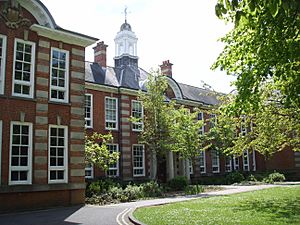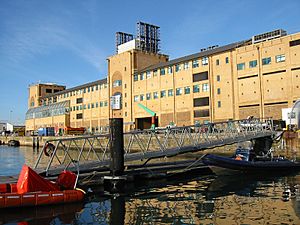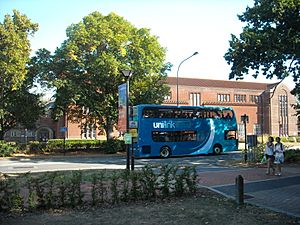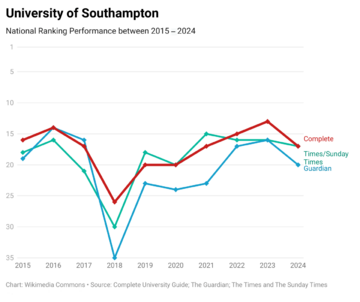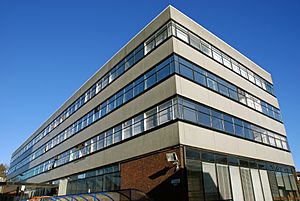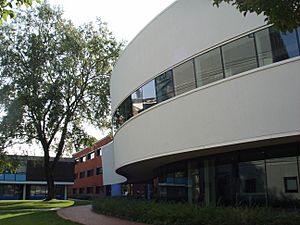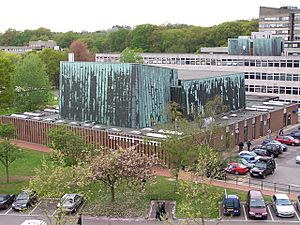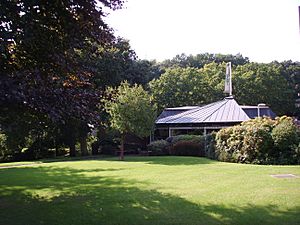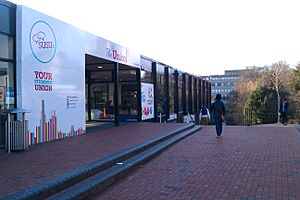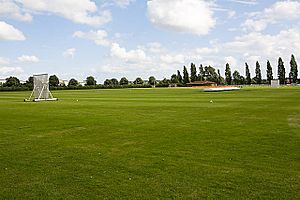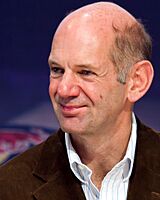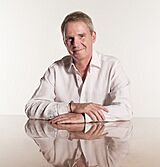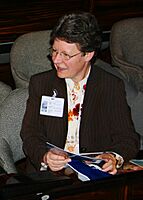University of Southampton facts for kids
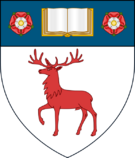
|
|
| Latin: Universitas Hantoniensis | |
| Motto | Latin: Strenuis Ardua Cedunt |
|---|---|
|
Motto in English
|
The Heights Yield to Endeavour |
| Type | Public research university |
| Established |
|
| Endowment | £11.9 million (2023) |
| Budget | £722.4 million (2022/23) |
| Chancellor | Justine Greening, Lord Patel of Bradford |
| Vice-Chancellor | Mark E. Smith |
| Visitor | Lucy Powell (as Lord President of the Council ex officio) |
|
Academic staff
|
2,600 (2021/22) |
|
Administrative staff
|
3,380 (2021/22) |
| Students | 23,795 (2021/22) |
| Undergraduates | 15,110 (2021/22) |
| Postgraduates | 8,685 (2021/22) |
| Location |
Southampton, Hampshire, England
50°56′05″N 1°23′45″W / 50.93463°N 1.39595°W |
| Campus | City Campus |
| Colours | Marine Blue |
| Affiliations |
|
 |
|
The University of Southampton is a big public university in Southampton, England. It's known for its research and is a founding member of the Russell Group, which includes some of the best research universities in the United Kingdom.
The university has seven campuses, including its main one in Highfield, Southampton. There are also campuses for humanities, oceanography, medicine, and engineering. Plus, there's an art school in nearby Winchester and an international campus in Malaysia for engineering students. Each campus has its own library.
The University of Southampton is the largest university in the South East region by student numbers. It has 17,535 undergraduate students and 7,650 postgraduate students. The University of Southampton Students' Union helps students with support, representation, and fun activities. Students can join over 200 clubs and 80 sports teams.
Contents
History of the University
How it Started: Hartley Institution
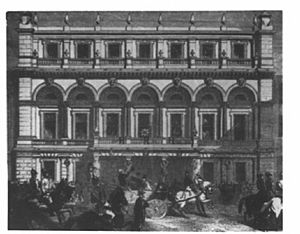
The University of Southampton began as the Hartley Institution in 1862. It was created thanks to a generous gift from Henry Robinson Hartley. He left a lot of money to the Southampton Corporation to help people study and learn about sciences.
Hartley wanted to create a cultural center for smart people in Southampton. After some discussions, the Southampton Corporation decided to build the Hartley Institute.
On October 15, 1862, the Hartley Institute officially opened. The Prime Minister, Lord Palmerston, was there for the big event. After a few tough years, the Hartley Institute became Hartley College in 1883. More students and teachers joined, and the college grew.
Becoming a University College
In 1902, Hartley College became the Hartley University College. This meant it could award degrees from the University of London. This happened after experts checked its teaching and money.
More students meant the college needed a bigger space. So, it moved to a new area in Highfield, Southampton. The new site opened on June 20, 1914. However, the First World War started soon after, and the buildings were used as a military hospital. After the war, the college moved from its old location in 1920.
During the 1920s and 1930s, the university grew even more, thanks to private donations. For example, the university library was built with money from Edward Turner Sims's daughters. During World War II, the university was damaged by bombs. But it kept going, even expanding its engineering and radio departments.
Becoming a Full University
On April 29, 1952, Queen Elizabeth II gave the University of Southampton a special document called a royal charter. This was the first one she gave to a university during her reign. It meant the university could now award its own degrees.
Six main study areas were created: Arts, Science, Engineering, Economics, Education, and Law. The first University of Southampton degrees were given out on July 4, 1953. The number of students and staff grew a lot in the following years. The campus also got much bigger. New departments like Medicine and Oceanography were also started.
In the 1980s and 1990s, the university continued to expand. New buildings were added, and a science park was developed. The National Oceanography Centre was also opened by the docks.
Focus on Research
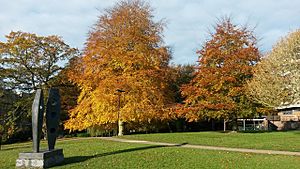
In the mid-1990s, the university focused more on research. It also welcomed two new campuses: the Winchester School of Art and La Sainte Union College. A new school for Nursing and Midwifery was also created. This meant many more students joined the university.
In 1997, the university faced a health challenge when there was an outbreak of meningitis. The university quickly organized a mass vaccination program to protect its students.
The university celebrated its 50th birthday in 2002. By this time, more than half of its income came from research. In recent years, many new buildings have been added to the main campus, like the Jubilee Sports Complex and the Life Sciences building. The Hartley Library and Students' Union also got bigger and better.
In 2013, the university joined the Science and Engineering South Consortium (SES). This group works with top universities like Oxford and Cambridge to share ideas and resources for science and engineering research.
In 2015, the university started raising money for a new Centre for Cancer Immunology. They reached their goal of £25 million in 2018. This center is the first of its kind in the UK. It helps scientists study how our bodies' immune systems can fight cancer.
University Campuses
The University of Southampton has seven campuses where students learn. Five are in Southampton, one is in Winchester, and there's an international campus in Malaysia. The university also has a science park in Chilworth.
Highfield Campus
This is the university's main campus, located in a residential area of Highfield. It opened in 1914 and was used as a military hospital during World War I. Over time, many red brick buildings were added, like the Hartley Library.
In 1956, a plan was made to design the campus for the future. More modern buildings were added, using materials like concrete and glass. In recent years, new buildings have continued to be built, and older ones have been updated.
Avenue Campus
Avenue Campus is where the Faculty of Humanities is located, except for Music. It's a short walk from the main Highfield campus. The university bought this land in 1993 to expand. The campus has an old building from the early 1900s that has been updated, and a new Archaeology building built in 2006.
Boldrewood Campus
Boldrewood Campus is close to Highfield campus. It's home to the university's new Maritime Centre of Excellence. This center focuses on engineering and maritime technology. It also houses Lloyd's Register's Global Technology Centre.
National Oceanography Centre, Southampton
The National Oceanography Centre, Southampton (NOCS) is located in Southampton Docks, about three miles south of the main campus. This campus is where the university's Ocean and Earth Sciences department is based. It's also a research institute for the Natural Environment Research Council.
The campus was planned in 1989 and opened in 1996 by Prince Philip, Duke of Edinburgh. It used to be the base for important research ships like the RRS James Cook and RRS Discovery.
University Hospital Southampton (UHS)
The university works with the NHS at Southampton General Hospital. This is where some parts of the Faculty of Medicine and the Faculty of Health Sciences are located. It's a teaching hospital, so many medical students and researchers learn and work here.
The university started its involvement here in 1971. It was one of the first universities to have a new school of medicine.
Winchester School of Art
The Winchester School of Art is in central Winchester. It's where the university's arts and textiles courses are taught. The school joined the University of Southampton in 1996. The campus has its original buildings from the 1960s, plus new ones added after the merger.
Malaysia Campus
The university opened its first international campus in Iskandar Puteri, Malaysia, in October 2012. It's called the University of Southampton Malaysia. This campus is in EduCity, a new area with many universities.
The Malaysia campus offers engineering courses. Students can study for two years in Malaysia and then finish their last two years in Southampton. The campus has modern facilities like an Aerospace Lab and Design Studio. It offers 20 programs in Engineering, Business, and Computer Science.
The University of Southampton Malaysia is the only British university campus in Malaysia that is ranked among the world's top 100 universities.
Science Park
The University of Southampton Science Park has about 50 businesses that work with the university. It started in 1983 as Chilworth Science Park. The park helps new companies grow. These companies work in many different fields, like oil and gas, medicine, and nanotechnology.
Transport Around the University
To help students and staff get around, the university runs the Unilink bus service. These buses connect the university's campuses, student housing, hospitals, and other important places in the city. Students living in university housing often get a free bus pass.
How the University is Run
Leadership and Management
The university is led by the Vice-Chancellor, currently Professor Mark E. Smith. The main groups that run the university are the Council and the Senate.
The Council is in charge of the university's overall planning and management. It makes sure that money given to the university is used correctly. The Senate is the main academic authority. It's responsible for education, exams, awarding degrees, and promoting research.
University Study Areas (Faculties)
The university has five main faculties, each with different academic departments. This structure started in 2018.
- Faculty of Arts and Humanities
- Humanities
- Winchester School of Art
- Faculty of Engineering and Physical Sciences
- Chemistry
- Electronics and Computer Science
- Engineering
- Optoelectronics Research Centre
- Physics and Astronomy
- Faculty of Environmental and Life Sciences
- Biological Sciences
- Geography and Environmental Science
- Health Sciences (nursing, midwifery, allied health professionals)
- Ocean and Earth Sciences
- National Oceanography Centre
- Psychology
- Faculty of Medicine
- Southampton Medical School
- Cancer Sciences
- Clinical and Experimental Sciences
- Healthcare Enterprise and Innovation
- Human Development and Health
- Primary Care, Population Sciences and Medical Education
- Faculty of Social Sciences
- Economic, Social and Political Sciences
- Southampton Statistical Sciences Research Institute
- Mathematical Sciences
- Southampton Business School
- Southampton Education School
- Southampton Law School
University Connections
Southampton is a founding member of the Russell Group. This group includes leading research-focused universities in Britain.
What You Can Study and Learn
Degrees and Courses
Southampton offers many different types of degrees, from bachelor's degrees to master's degrees and even higher doctorates. The university also works with the British Army and Royal Navy to provide special training and qualifications.
Getting In: Admissions
| 2023 | 2022 | 2021 | 2020 | 2019 | |
|---|---|---|---|---|---|
| Applications | 45,280 | 43,255 | 37,580 | 35,800 | 35,795 |
| Accepted | 5,235 | 5,075 | 5,315 | 4,560 | 4,210 |
| Applications/Accepted Ratio | 8.6 | 8.5 | 7.1 | 7.9 | 8.5 |
| Offer Rate (%) | 71.7 | 69.2 | 63.9 | 67.8 | 68.0 |
| Average Entry Tariff | N/A | N/A | 156 | 155 | 152 |
Southampton is a popular university. In 2023, it was ranked 25th in Britain for the average grades of students who got in. The university offers places to about 84% of its applicants, which is one of the highest rates among the Russell Group universities.
In the 2016–17 school year, about 72% of students were from the UK, 7% from the EU, and 21% from other countries. About 60.5% of international students were from China.
Rankings and Reputation
| National rankings | |
|---|---|
| Complete (2021) | 20 |
| Guardian (2021) | 20 |
| Times / Sunday Times (2021) | 17 |
| Global rankings | |
| ARWU (2020) | 151–200 |
| QS (2021) |
80= |
| THE (2021) | 97= |
The University of Southampton is highly regarded around the world. In 2023, it was ranked 78th globally by QS World University Rankings. It was also ranked 97th by Times Higher Education World University Rankings.
In 2018, Southampton received a Silver award in the Teaching Excellence Framework. This award recognizes the quality of undergraduate teaching at universities in England.
The Guardian newspaper ranked the university number 1 in the UK for Civil Engineering and Electronic and Electrical Engineering in 2020.
The university is also known for its strong research. In 2021, it was ranked 17th in the UK for the quality of its research.
Research at Southampton
The university does research in many different subjects. It has several important research centers. Southampton is a leader in fields like music, computer sciences, engineering, and oceanography. It also has world-leading research in web science.
Institute of Sound and Vibration Research
The Institute of Sound and Vibration Research (ISVR) is a special institute that studies sound and vibration. It's part of the University of Southampton and was founded in 1963. It has even won an award for its work!
ISVR has four main research groups:
- The Dynamics Group studies how things vibrate.
- The Fluid Dynamics and Acoustics Group looks at sounds from aircraft engines and underwater acoustics.
- The Human Sciences Group studies how people react to sound and vibration.
- The Signal Processing and Control Group uses signals to control sound and vibration.
ISVR offers degrees in acoustical engineering, acoustics & music, and audiology.
EPrints: Sharing Research Online
The School of Electronics and Computer Science created special software called EPrints. This software helps the university share its research freely on the internet. Many other institutions around the world also use EPrints to store and share their research.
University Libraries
The university has libraries on each of its campuses. Together, they hold over 1.5 million books and magazines!
The main library is the Hartley Library, located on Highfield campus. It was first built in 1935 and has been expanded several times. Most of the books are here. It also has special collections of old and rare books, including letters from famous people like Arthur Wellesley, 1st Duke of Wellington.
Besides the Hartley Library, there are other libraries on the university's other campuses. These libraries focus on the subjects taught at those locations. For example, the library at the National Oceanography Centre has many books on oceanography.
Arts and Culture
The main Highfield campus has three important arts venues. The Nuffield Theatre opened in 1963. It was designed by Sir Basil Spence and was used for plays and lectures. The theatre closed in July 2020.
The Turner Sims Concert Hall was added in 1974. It was built specifically for music performances. The hall was designed to have excellent sound quality.
The John Hansard Gallery opened in 1980. It shows various exhibitions of modern art.
The Highfield campus also has several cool sculptures by famous artists like Barbara Hepworth.
Student Life
Students' Union
The University of Southampton Students' Union (SUSU) is like a student government and activity center. It has facilities on the Highfield campus and at the Winchester School of Art. On Highfield, the union is in three buildings. The main building was built in the 1960s and was updated in 2002. It has bars and a multi-functional space called 'The Cube'.
The union also runs four media outlets:
- Surge Radio: An internet radio station.
- SUSUtv: An internet TV station with live and on-demand shows.
- Wessex Scene: The student newspaper, published every three weeks.
- The Edge: An entertainment magazine.
Student Housing (Halls of Residence)
The university offers housing for all first-year students who need it. There are also places for international and postgraduate students. Some rooms have meals included, while others are self-catered. Each hall has a student committee that plans social events.
The university has several large student housing complexes:
- Glen Eyre Complex: This complex is north of Highfield Campus and houses about 2000 students. It has several buildings, some older and some more modern. All rooms here are self-catered.
- Wessex Lane Halls: Located east of Highfield Campus, this complex houses over 1,800 students. It includes Montefiore Hall and Connaught. Connaught Halls provide catered meals.
- City Gateway Hall: Opened in 2015, this building is known for its unique design, including a 15-story tower. It houses up to 375 students.
- Mayflower Halls: Located in the city center, this hall opened in 2014 and houses over 1100 students. It also has a gym.
- Archers Road: This area has two halls, Gateley and Romero, which are self-catered.
- Highfield Halls: These halls are close to Avenue Campus and offer catered meals.
- Gower Building: This building on Highfield campus has apartments for older and postgraduate students.
- Erasmus Park: Located in Winchester, this hall houses students from the Winchester School of Art.
- Riverside Way: Also in Winchester, this is a private hall where some university students live.
Student Healthcare
The University Health Service is a doctor's office located on the main Highfield campus. It serves over 20,000 patients.
Sports and Wellbeing
The university has many sports facilities. The main ones are the Jubilee Sports Centre and Wide Lane Sports Ground. The Jubilee Sports Centre, opened in 2004, has a swimming pool, a large gym, and a sports hall. Wide Lane Sports Ground, updated in 2007, is a huge complex with pitches for different sports, tennis courts, and a gym.
The university also has sports facilities at other campuses and student housing. Students can use a sports hall, squash courts, and a climbing wall at the Students' Union.
The university competes in many sports through BUCS. Many sports clubs, like Cricket, Football, Rugby, and Tennis, have been around since before the 1900s.
Mustangs Baseball Club
The Southampton Mustangs Baseball Club started in 1997. At first, they played friendly games against other university teams. In 2004, the Mustangs joined the national adult baseball leagues. They have worked their way up to play in the top league of British baseball.
Famous People from Southampton University
Alumni (Former Students)
-
Justine Greening, former MP
-
Adrian Newey, Formula One Engineer
Academics (Teachers and Researchers)
Many important people have worked at the university, including:
- Sir Tim Berners-Lee, who invented the World Wide Web.
- Wendy Hall, who helped create a system that was a bit like the World Wide Web before it existed.
- Erich Zepler, who made big improvements to radio receivers.
- David Payne, who invented a key part for fibre optics cables.
- Sir Barry Cunliffe, a famous archaeologist.
-
Sir Tim Berners-Lee, computer scientist
-
Sir Nigel Shadbolt, computer scientist
-
Dame Jocelyn Bell Burnell, astrophysicist
See also
 In Spanish: Universidad de Southampton para niños
In Spanish: Universidad de Southampton para niños


